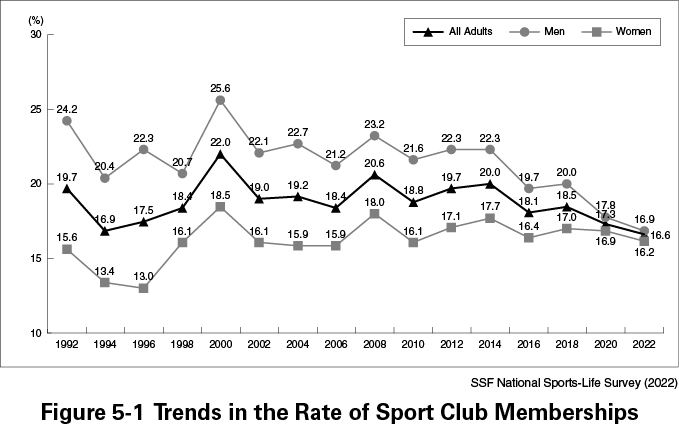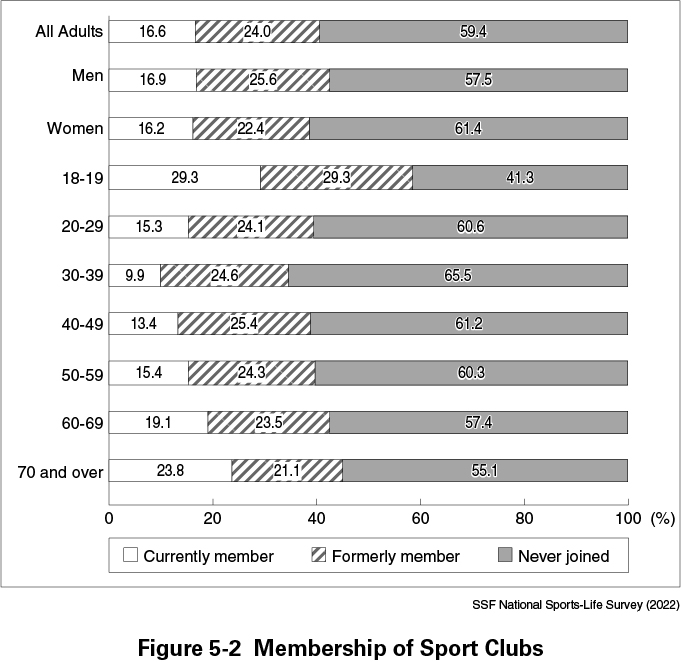This article highlights the following points;
1. Membership Trends and Types of Sport Clubs Membership Trends
We use cookies to optimize and continuously improve our website for individual users. By closing this banner or continuing to view the website, you are agreeing to the use of cookies for this purpose, as detailed in our Privacy Policy.
This article highlights the following points;
1. Membership Trends and Types of Sport Clubs Membership Trends
According to “The 2022 SSF National Sports-Life Survey”, the percentage of adults who were enrolled in a sport club, team or group (hereinafter collectively referred to as a “sport club”) at the time of the survey, was only 16.6% (Figure 5-1). In 1992 when the survey began, the membership rate was 19.7%, declining to 16.9% in 1994 before continuing to rise to 22.0% in 2000. It then declined again to 18.4% in 2006, but has remained flat overall. Starting at 20.0% in 2014, it has been a declining again to 18.1% in 2016, 18.5% in 2018 and 17.3% in 2020, then reaching 16.6% in 2022, the lowest rate since the first survey.

With regard to gender, the proportion of men who were enrolled in a sport club at the time of the survey was 16.9% and the proportion of women was 16.2%, showing little difference by gender (Figure 5-2). Conversely, in terms of those who had never enrolled in any sport clubs, the proportion of women was 3.9 percentage points higher (61.4%) than the proportion of men (57.5%).
By age groups, the 18-19 age group showed the highest membership rate of 29.3%, followed by the 70 and over age group with 23.8%, the 60-69 age group with 19.1%, the 50-59 age group with 15.4%, the 20-29 age group with 15.3%, the 40-49 age group with 13.4% and the 30-39 age group with 9.9%. In terms of those who had never enrolled in any sport clubs, the 30-39 age group had the highest non-membership rate of 65.5%.

Regarding the types of sport clubs that adults participated in, the most popular clubs were “Local community clubs (mostly managed by local residents)” at 30.8%, followed by “Friends and acquaintances’ clubs”, “Private sport clubs and fitness clubs”, “Workplace clubs” and “Alumni clubs”.
By gender, the proportion of women who were members of “Private sport clubs and fitness clubs” was 19.0 percentage points higher (34.0%) than men (15.0%). The same trend was observed in “Local community clubs”, with women (32.8%) leading men (28.9%) by 3.9 percentage points. By age, the proportion of “Local community clubs” was higher among the 60-69 age group (39.8%) and among the 70 and over age group (39.2%). In contrast, the proportion of “Workplace clubs” was higher among the 20-29 age group (21.1%) and among the 30-39 age group (23.3%). In addition, the proportions of the 50-59 and 60-69 age groups who were members of “Private sport clubs and fitness clubs” were higher than those of other age groups, at 32.1% and 32.3%, respectively.
Among respondents who were not currently enrolled in any sport clubs, the proportion of those who would like to become a sport club member was 15.2%. This figure has decreased by 4.3 percentage points from 19.5% in 2016, but increased by 1.3 percentage points from 13.9% in 2020. By gender, the proportion wanting to enroll in a sport club was higher in women with 16.7% than men with 13.8%. Compared to 2020, it increased by 1.8 percentage points for men and 1.0 percentage points for women.